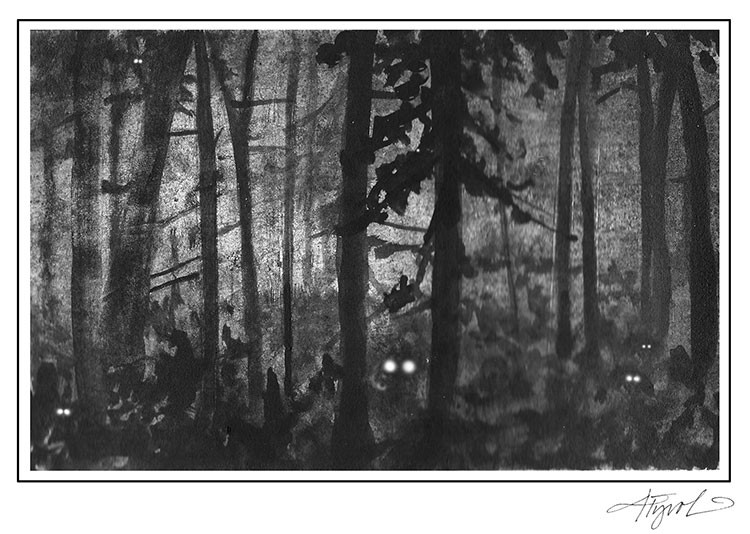
I’ve taken to wandering the night lately – one of the pleasures of having a puppy. Willow, my pup, and I walk at all hours, from twilight to midnight and into the shadowy early morning. Some nights we walk under the cover of stars and moonlight, and other nights the world is so dark my black dog disappears and I wonder what exactly is on the end of my leash.
Void of visual stimulus, any earthbound glimmer of light is noteworthy. One night I saw the glow of two small eyes, like gold coins caught in the arc of my headlamp. I watched the weasel – a long small body, and bold shimmering eyes – disappear down the crevice of a stonewall. Since then I’ve become obsessed with eyeshine.
Eyeshine in animals is produced by a special membrane, called the tapetum lucidum (“tapestry of light”), a reflective surface that is located directly behind the retina. When the small rays of light found in the night, like starlight or moonlight, enter the eye, they bounce off the membrane, giving the eye a second chance to use the light. For animals that have this membrane, it is like having a built in flashlight that lights a path from the inside out.
The tapetum lucidum, coupled with big eyes and lots of light-sensing rod cells, allow nocturnal mammals to see well in dark or dim conditions. But eyeshine isn’t limited to mammals. Once, while at the edge of a pond listening to the midnight chorus of frogs, my flashlight caught the glimmering, emerald-green eyes of a huge bullfrog. And in my obsession over eyeshine, I am eagerly looking forward to the summer, when I will be searching the forest floor for the ruby red glow of a wolf spider’s eyes. I only wish that my eyes would glow, a fierce sapphire blue in the darkest of night, but although humans have many interesting adaptations, good night vision is not one of them. Our abundance of cones and lack of rods mean we see more colors than most other animals, but we can’t see in the dark. And we don’t have a tapetum lucidum – when our eyes appear red in photographs, it’s a reflection of the camera’s flash off the red blood cells of the choroid, which is a vascular layer behind the retina.
Eyeshine color varies by species, from the amber glow of a bobcat to the red glint of a black bear. The different colors are produced by the mineral content and the structure of the tapetum lucidum, as well as varying pigments in the retina. There does seem to be some overlap of colors, like bobcat and raccoon having yellow/amber eyeshine.
So is it at all possible to identify an animal by eyeshine color alone? According to ecologist and long-time tracker Dr. Rick van de Poll, eyeshine is somewhat variable so that even within the same species the color can look a bit different. Factors that influence individual eyeshine color, according to van de Poll, include the age and individual chemistry of the animal, as well as seasonal variation and the angle and intensity of the light hitting the eye. But this doesn’t deter van de Poll from using eyeshine as a clue to identifying mammals. “It’s part of the information” he said, “but you have to also be paying attention to the animal’s behavior, the shape and placement of the eyes, and how the animal moves away from the light, or if it even moves away from the light at all.”
As we head out into the night, my headlamp strapped on above my eyes, I catch Willow’s red glowing eyes looking up at me. Out in front of us is a field, and we watch a set of green/white eyes lift up and turn towards us. These eyes are high and wide. There is a stamp and a snort and the eyes are gone – starlight on the move. My light catches the flash of a white tail as the deer disappears into the night.


Discussion *